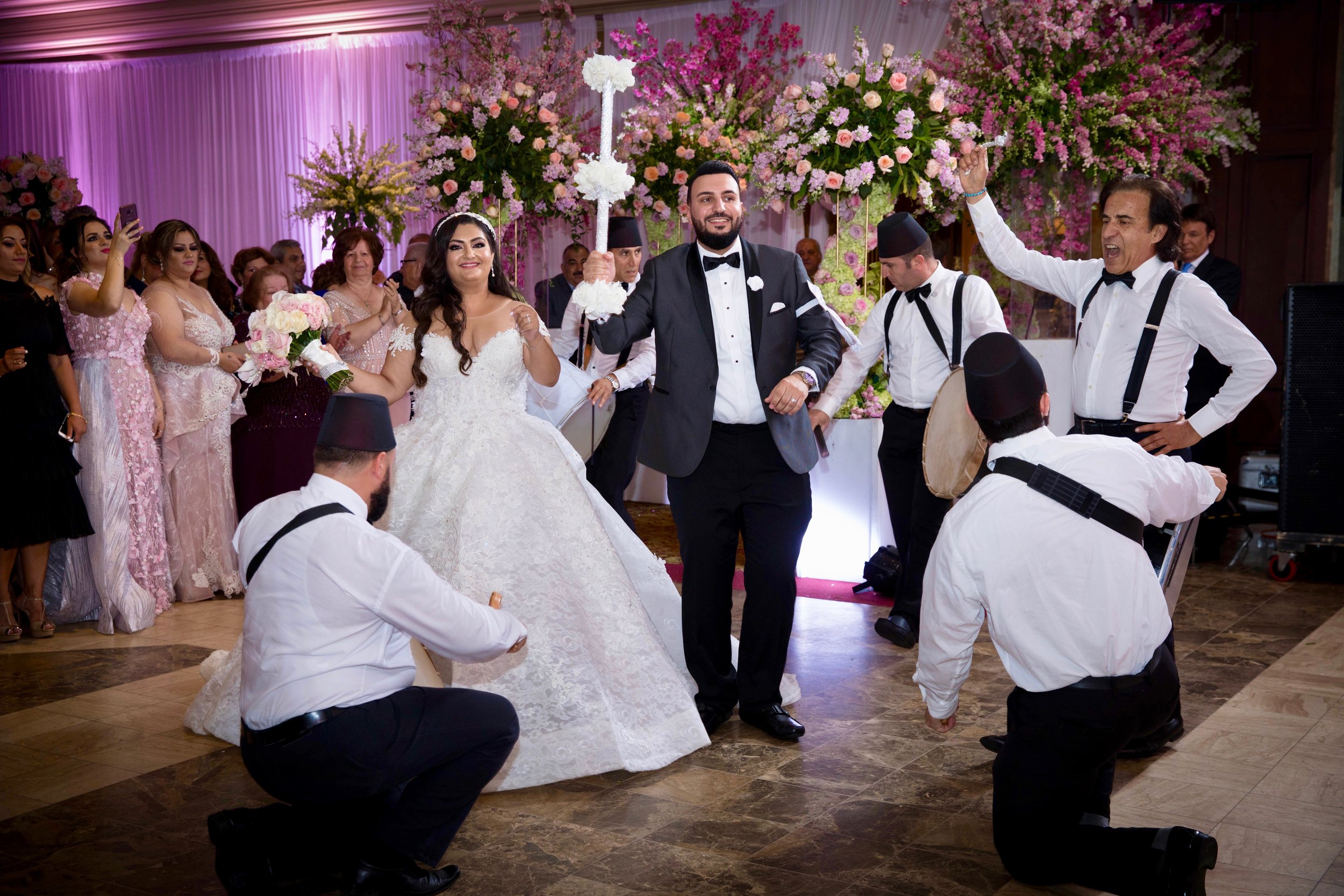Blending wedding traditions
Photo courtesy of Wali Kalou of Alluring Impressions.
By Lisa Cipriano
Weddings are inherently rooted in tradition. From Chaldean to American weddings, they’re all about tradition. So, how do you fit in each tradition and make it all work?
It’s rather simple according to wedding planners. They say to just do it! It will enrich your wedding ceremony and reception and make it more interesting and fun.
“I’ve found that non-Chaldeans actually really love the Chaldean wedding traditions. They love our music, dancing and they like to get involved,” said Suhair Kallabat, event/wedding planner and owner of Eventfully Yours.
Many of the rituals are very easy to incorporate and begin at the church ceremony.
“Most of the Chaldean traditions are ceremonial. For instance, the arm bows and crownings are a must have and are easily done,” explains Dalia Atisha, event/wedding planner and owner of The Event Planner Inc.
The arm bow, placed by the priest on the groom’s left arm as part of the ceremony, is considered a Sacrament with much significance and an essential part of a Chaldean wedding ceremony. “It’s a very similar presentation as the wedding ring. It represents eternity,” Atisha added.
The crowing of the bride and groom is another important Chaldean wedding ceremony ritual and also has its own significance liturgically.
“It represents the bride and groom being first in each other’s lives. They are their own king and queen, forming their own kingdom,” explained Atisha.
Some Chaldean traditions are very similar to American ones and can be blended quite easily and even add extra flair to the event. “The Chaldean community has become very westernized. So, it’s really not that difficult to combine the two cultures with their traditions,” Atisha said.
For instance, it’s both American and Chaldean tradition to introduce the bride, groom and wedding party as they enter the reception.
Photo courtesy of Kay Hilai of Capturing Arts
The Arabic Zeffa just makes that American tradition a lot more fun and festive with dancing and traditional, Chaldean Khiga music. It has evolved to include the cutting of the wedding cake.
“There used to be a separate Zeffa later in the night for the cake cutting, but people have found that it takes too much time away from the other activities. So, we’ve incorporated both into one,” explained Atisha. “The Zeffa is a must have, even if just one of the couple is Chaldean,” she added.
Ronza Novelli is a Chaldean who was born in Iraq. She grew up attending weddings of her culture and always dreamed of having those traditions at her big day. Despite her husband, Ezio, being of Italian decent, she managed to successfully combine elements of both cultures at her recent wedding.
“We hired a dance group called Arabian Knights to perform the Zeffa. They wore traditional costumes. We just love the Middle Eastern dancing and drums. That’s something that I absolutely had to have,” Novelli explained.
The effort to successfully combine Chaldean and American wedding traditions has left the more passé American traditions in the dust. There’s no need to plan time for the receiving line and bouquet and garter toss. “Those are things that are honestly becoming extinct in our Chaldean community,” Atisha said. “Actually, the bouquet and garter toss is being phased out of American wedding traditions as well. We’re seeing it less and less,” she added.
Novelli chose to include a bouquet toss at her Chaldean/Italian wedding, but did not do the garter removal or toss. “I really don’t think that’s appropriate for a Chaldean wedding,” she said.
Foregoing some of these fading American traditions also allows more time for the often lengthy, Zeffa and line dances that not only make your Chaldean guests happy, but your non-Chaldean guests will love them, too!
“I’ve noticed that the non-Chaldean wedding guest absolutely love and look forward to the line dancing. They are on that dance floor, want to learn and are embracing it just as much as someone who has been doing it forever,” Atisha explained.
Photo courtesy of Wali Kalou of Alluring Impressions
The Chaldean traditions of dancing with the Yalekhta and Kopala also make for a stunning, visual impact that is rich with ancient culture.
“There is so much culture in the Chaldean community. People, especially the millennials, love that! They want to be a part of it,” she added.
So, the more Chaldean and Middle Eastern music, the better, as it only enriches the event and keeps guests dancing all night long.
“Music stirs the soul. People love the flutes, drums and Middle Eastern dances,” agreed Kallabat.
In fact, most, if not all, Chaldean/American wedding receptions include both a traditional Chaldean band to play traditional music and dances and a deejay to spin the popular American dance hits.
“Most Chaldean bands actually come with a deejay to make blending to the American and Arabic cultures easier. It’s a way to kill two birds with one stone,” Atisha said.
For Novelli, this allowed her to accommodate both her Chaldean family and new Italian family with traditional music that they are accustomed to at wedding receptions.
“We had the deejay play all the different Italian songs and opera singers that my husband’s family know and like,” Novelli explained. “I know that weddings are for the bride and groom, but I tried to make sure that all of my guests were happy,” she concluded.
There are many more ancient Chaldean pre wedding traditions that can be performed. It’s all about what traditions are deemed essential to your family and important to the bride a groom.
“It’s all about customizing. Weddings are as unique as each individual couple. Do what’s right for you,” Kallabat concluded.
An experienced Chaldean/ American or even a non-Chaldean wedding planner with experience planning Chaldean weddings can help you make the right choices to help make everyone happy and create a special day that’s full of fun and rich with culture and tradition.



